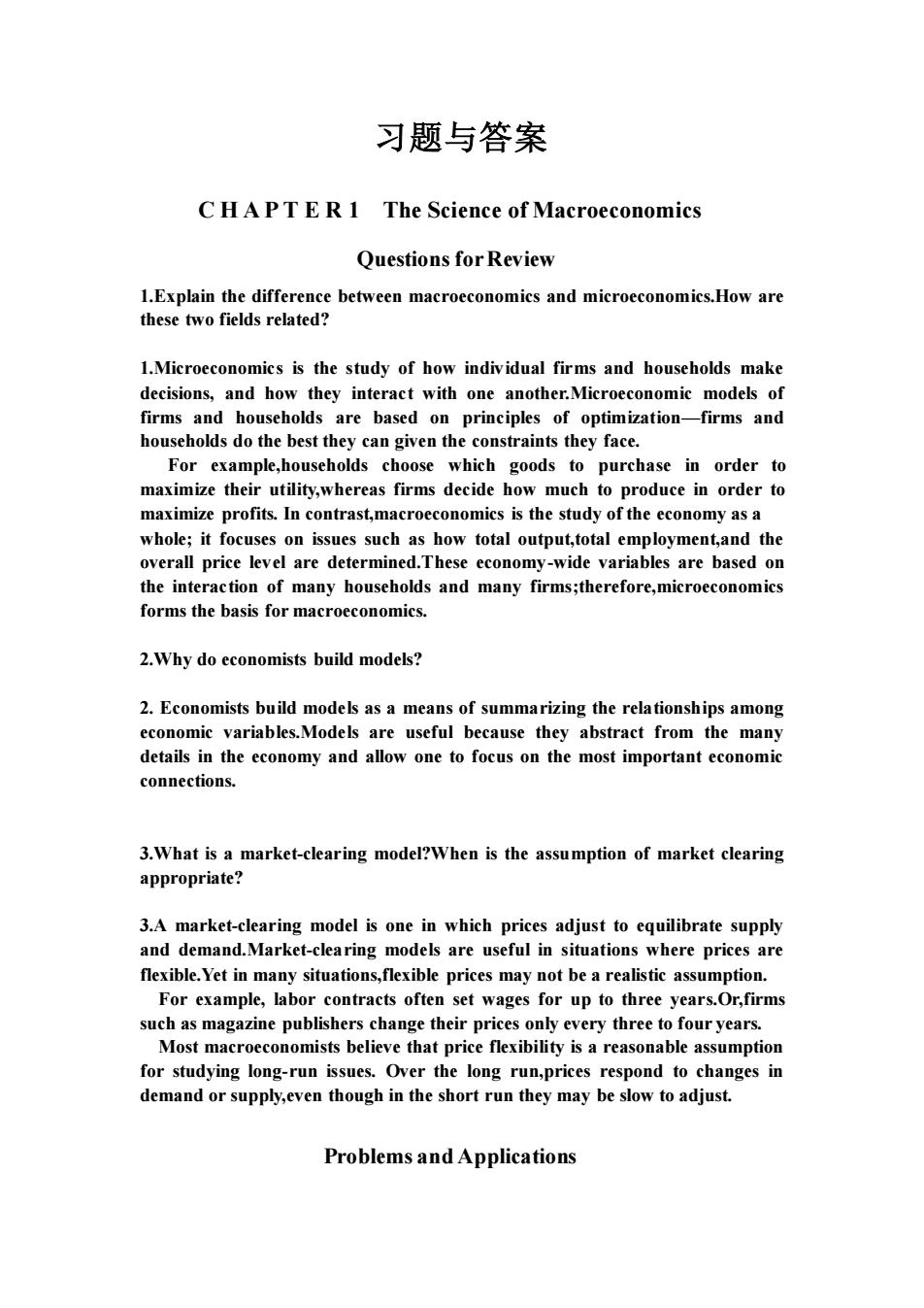
习题与答案 C HA PT E R 1 The Science of Macroeconomics Questions for Review 1.Explain the difference between macroeconomics and microeconomics.How are these two fields related? 1.Microeconomics is the study of how individual firms and households make decisions,and how they interact with one another.Microeconomic models of firms 0 are based on principles of optimization -firms and households do the best they can given the constraints they face. For example,households choose which goods to purchase in order to maximize their utility,whereas firms decide how much to produce in order to maximize profits.In contrast,macroeconomics is the study of the economy as a whole;itf cuses issu s such ow total outpu tal employment,and the overall price level are determined.These economy-wide variables are based on the interaction of many households and many firms;therefore,microeconomics forms the basis for macroeconomics. 2.Why do economists build models? 2.Economists build models as a means of summarizing the relationships among economic variables.Models are useful because they abstract from the many details in the economy and allow one to focus on the most important economic connections. 3.What is a market-clearing model?When is the assumption of market clearing appropriate? 3.A market-clearing model is one in which prices adjust to equilibrate supply and demand.Market-clearing models are useful in situations where prices are flexible.Yet in many situations,flexible prices may not be a realistic assumption. For example,labor contracts often set wages for up to three years.Or,firms such as magazine publishers change their prices only every three to four vears. Most macroeconomists believe that price flexibility is a reasonable assumption for studying lo 2-ru ove ong run,prices ond to demand or supply,even though in the short run they may be slow to adjust. Problems and applications
习题与答案 C H A P T E R 1 The Science of Macroeconomics Questions for Review 1.Explain the difference between macroeconomics and microeconomics.How are these two fields related? 1.Microeconomics is the study of how individual firms and households make decisions, and how they interact with one another.Microeconomic models of firms and households are based on principles of optimization—firms and households do the best they can given the constraints they face. For example,households choose which goods to purchase in order to maximize their utility,whereas firms decide how much to produce in order to maximize profits. In contrast,macroeconomics is the study of the economy as a whole; it focuses on issues such as how total output,total employment,and the overall price level are determined.These economy-wide variables are based on the interaction of many households and many firms;therefore,microeconomics forms the basis for macroeconomics. 2.Why do economists build models? 2. Economists build models as a means of summarizing the relationships among economic variables.Models are useful because they abstract from the many details in the economy and allow one to focus on the most important economic connections. 3.What is a market-clearing model?When is the assumption of market clearing appropriate? 3.A market-clearing model is one in which prices adjust to equilibrate supply and demand.Market-clearing models are useful in situations where prices are flexible.Yet in many situations,flexible prices may not be a realistic assumption. For example, labor contracts often set wages for up to three years.Or,firms such as magazine publishers change their prices only every three to four years. Most macroeconomists believe that price flexibility is a reasonable assumption for studying long-run issues. Over the long run,prices respond to changes in demand or supply,even though in the short run they may be slow to adjust. Problems and Applications
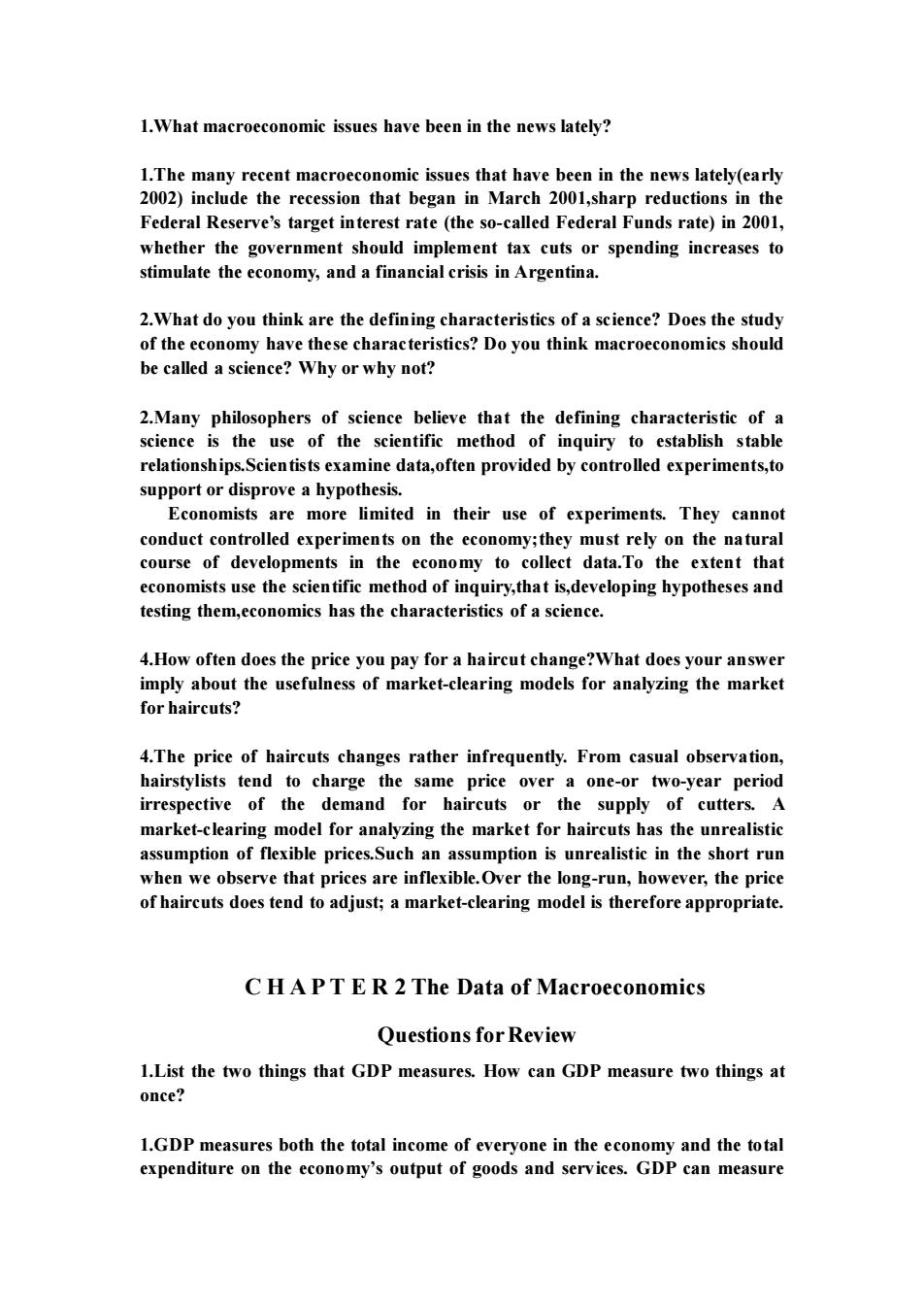
1.What macroeconomic issues have been in the news lately? 1.The many recent macroeconomic issues that have been in the news lately(early 2002)include the recession that began in March 2001,sharp reductions in the Federal Reserve's target interest rate(the so-called Federal Funds rate)in 2001, whether the government should implement tax cuts or spending increases to stimulate the economy,and a financial crisis in Argentina. 2.What do you think are the defining characteristics of a science?Does the study of the economy have these characteristics?Do you think macroeconomics should be called a science?Why or why not? 2.Many phil sophers of science believe that the defining characteristic of a science is the use of the scientific method of inquiry to establish stable relationships.Scientists examine data,often provided by controlled experiments,to support or disprove a hypothesis. Economists are more limited in their use of experiments.They cannot conduct controlled experiments on the economy;they must rely on the natura course of developments in the economy to collect data.To the extent that economists use the scientific method of inquiry,that is,developing hypotheses and testing them,economies has the characteristics of a science. 4.How often does the price you pay for a haircut cha nge?What c does yo ur answe imply about the usefulness of market-clearing modek s for analyzing the marke for haircuts? 4.The price of haircuts changes rather infrequently.From casual observation, hairstylists nd to cha rge the sam one-or eriod demand irrespe of the for haircuts 01 the supply cutter A market-clearing model for analyzing the market for haircuts has the unrealistic assumption of flexible prices.Such an assumption is unrealistic in the short run when we observe that prices are inflexible.Over the long-run,however,the price of haircuts does tend to adjust;a market-clearing model is therefore appropriate. C HA PT E R 2 The Data of Macroeconomics Questions for Review 1.List the two things that GDP measures.How can GDP measure two things at once? 1GDP measures both the total income of evervone in the economy and the total expenditure on the economy's output of goods and services.GDP can measure
1.What macroeconomic issues have been in the news lately? 1.The many recent macroeconomic issues that have been in the news lately(early 2002) include the recession that began in March 2001,sharp reductions in the Federal Reserve’s target interest rate (the so-called Federal Funds rate) in 2001, whether the government should implement tax cuts or spending increases to stimulate the economy, and a financial crisis in Argentina. 2.What do you think are the defining characteristics of a science? Does the study of the economy have these characteristics? Do you think macroeconomics should be called a science? Why or why not? 2.Many philosophers of science believe that the defining characteristic of a science is the use of the scientific method of inquiry to establish stable relationships.Scientists examine data,often provided by controlled experiments,to support or disprove a hypothesis. Economists are more limited in their use of experiments. They cannot conduct controlled experiments on the economy;they must rely on the natural course of developments in the economy to collect data.To the extent that economists use the scientific method of inquiry,that is,developing hypotheses and testing them,economics has the characteristics of a science. 4.How often does the price you pay for a haircut change?What does your answer imply about the usefulness of market-clearing models for analyzing the market for haircuts? 4.The price of haircuts changes rather infrequently. From casual observation, hairstylists tend to charge the same price over a one-or two-year period irrespective of the demand for haircuts or the supply of cutters. A market-clearing model for analyzing the market for haircuts has the unrealistic assumption of flexible prices.Such an assumption is unrealistic in the short run when we observe that prices are inflexible.Over the long-run, however, the price of haircuts does tend to adjust; a market-clearing model is therefore appropriate. C H A P T E R 2 The Data of Macroeconomics Questions for Review 1.List the two things that GDP measures. How can GDP measure two things at once? 1.GDP measures both the total income of everyone in the economy and the total expenditure on the economy’s output of goods and services. GDP can measure
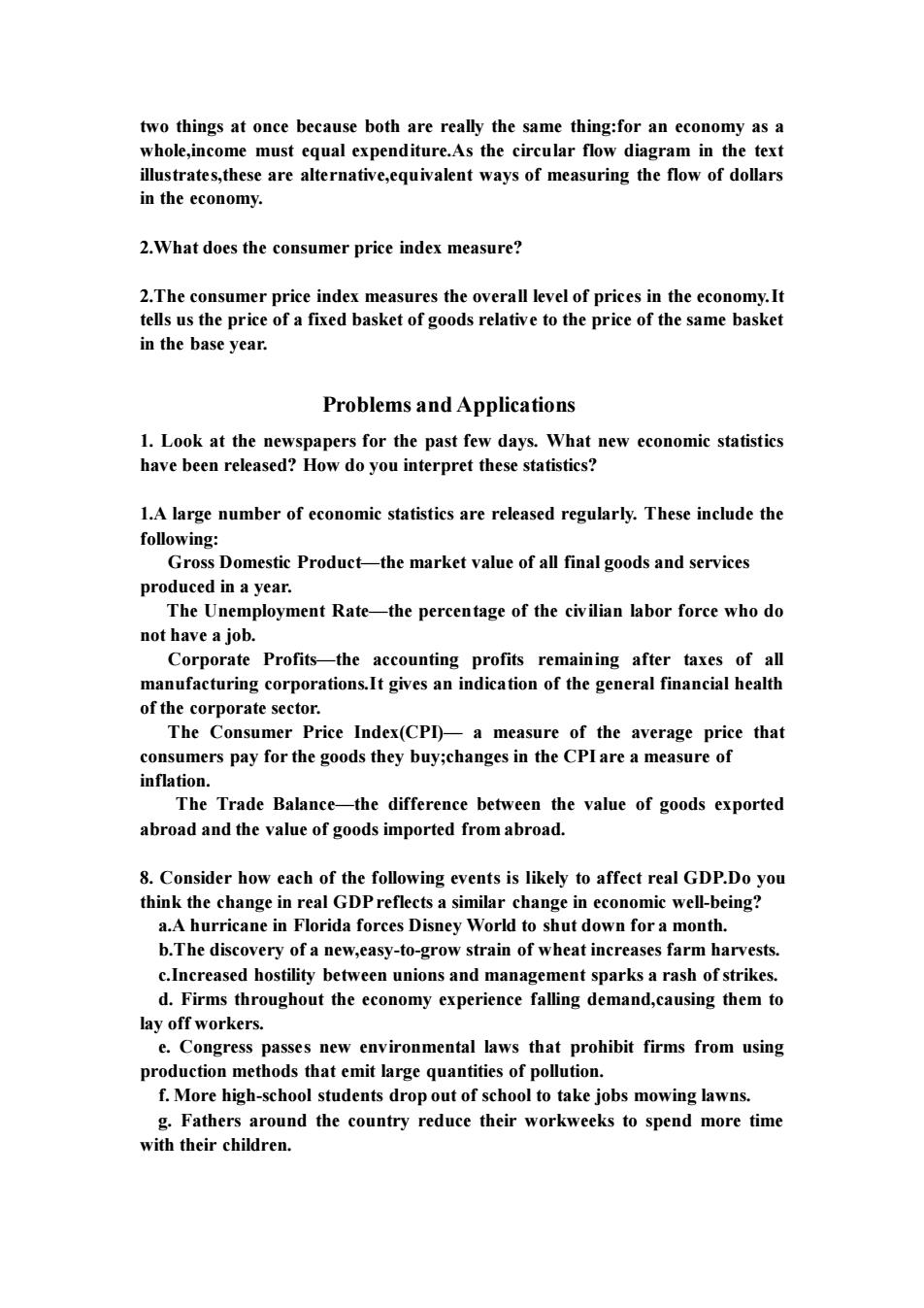
two things at once because both are really the same thing:for an economy as a w dia m in the text illustrates,these are alternative,equivalent ways of measuring the flow of dollars in the economy. 2.What does the consumer price index measure? 2.The consumer price inde ex measures the overall level of prices in the economy.It tells us the price of a fixed basket of goods relative to the price of the same basket in the base year. Problems and Applications 1.Look at the newspapers for the past few days.What new economic statistics have been released?How do you interpret these statistics? 1.A large number of economic statistics are released regularly.These include the Domestic Product-the market value of all final goods and services produced in a year. The Unemployment Rate-the percentage of the civilian labor force who do not have a job. Corpo rate Profits the ac unting profits remaining after taxes of all of the corporate sector. The Consumer Price Index(CPD- a measure of the average price that consumers pay for the goods they buy;changes in the CPIare a measure of inflation. The Trade Balancethe difference between the value of goods exported abroad and the value of goods imported from abroad. 8.Consider how each of the following events is likely to affect real GDP.Do you think the change in real gDPreflects a similar change in economic well-being? a.A hurricane in Florida forces Disney World to shut down for a month. b.The disco very of a new,easy-to-grow strain of wheat increases farm harvests c.Increased hostility between unions and management sparks a rash of strikes d.Firms throughout the economy experience falling demand,causing them to lay off workers. e.Congress passes new environmental laws that prohibit firms from using ods tha mit I large qua g.Fathers around the country reduce their workweeks to spend more time with their children
two things at once because both are really the same thing:for an economy as a whole,income must equal expenditure.As the circular flow diagram in the text illustrates,these are alternative,equivalent ways of measuring the flow of dollars in the economy. 2.What does the consumer price index measure? 2.The consumer price index measures the overall level of prices in the economy.It tells us the price of a fixed basket of goods relative to the price of the same basket in the base year. Problems and Applications 1. Look at the newspapers for the past few days. What new economic statistics have been released? How do you interpret these statistics? 1.A large number of economic statistics are released regularly. These include the following: Gross Domestic Product—the market value of all final goods and services produced in a year. The Unemployment Rate—the percentage of the civilian labor force who do not have a job. Corporate Profits—the accounting profits remaining after taxes of all manufacturing corporations.It gives an indication of the general financial health of the corporate sector. The Consumer Price Index(CPI)— a measure of the average price that consumers pay for the goods they buy;changes in the CPI are a measure of inflation. The Trade Balance—the difference between the value of goods exported abroad and the value of goods imported from abroad. 8. Consider how each of the following events is likely to affect real GDP.Do you think the change in real GDP reflects a similar change in economic well-being? a.A hurricane in Florida forces Disney World to shut down for a month. b.The discovery of a new,easy-to-grow strain of wheat increases farm harvests. c.Increased hostility between unions and management sparks a rash of strikes. d. Firms throughout the economy experience falling demand,causing them to lay off workers. e. Congress passes new environmental laws that prohibit firms from using production methods that emit large quantities of pollution. f. More high-school students drop out of school to take jobs mowing lawns. g. Fathers around the country reduce their workweeks to spend more time with their children
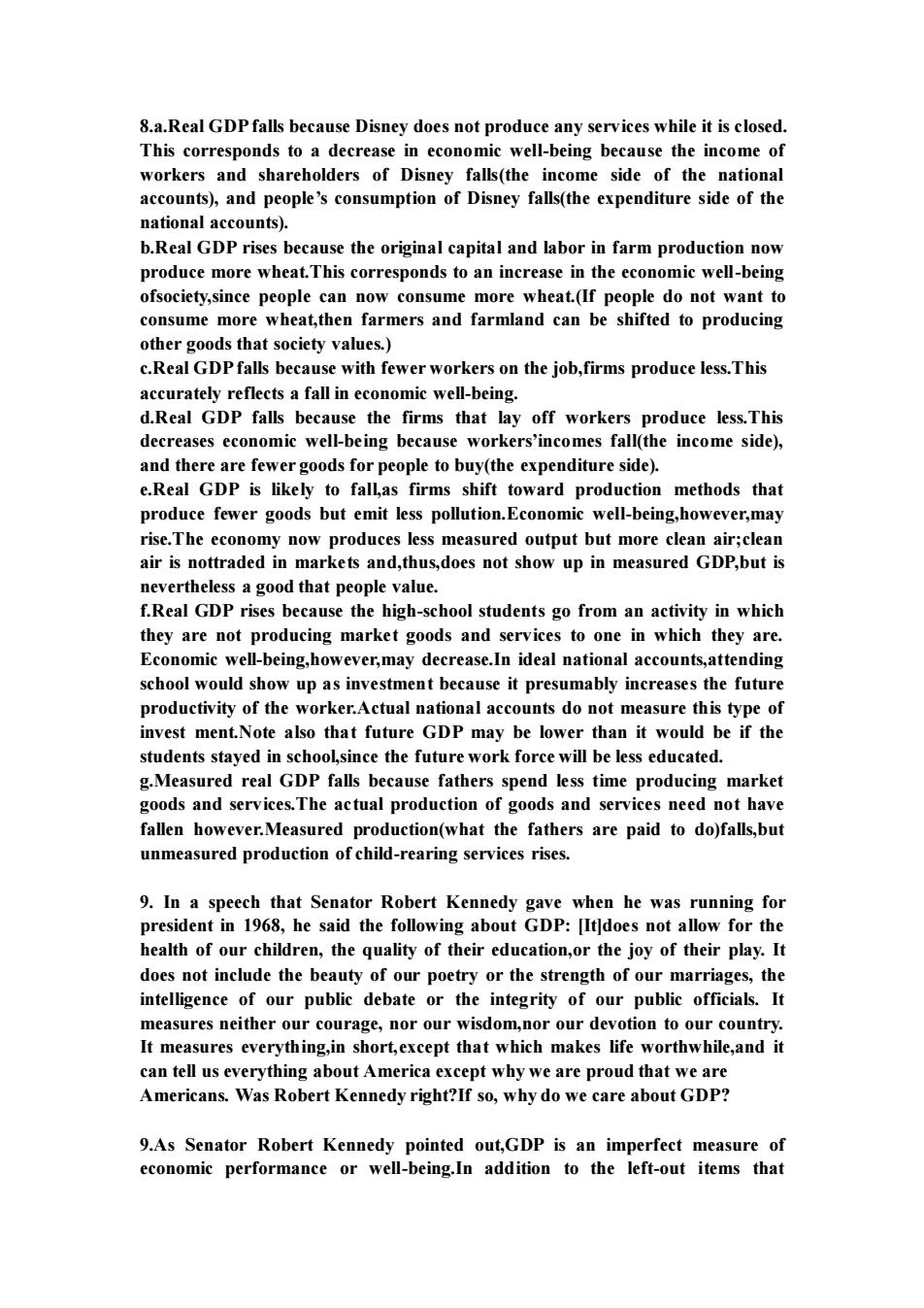
8.Real because Disney. This corresponds to a deerease in economi well-being beecause the income of workers and shareholders of Disney falls(the income side of the national accounts),and people's consumption of Disney falls(the expenditure side of the national accounts). b.Real GDP rises because the original capital and labor in farm production now ce more wheat.This corresponds to an increase in a the eco ono well-being ofsociety,since people can now consume more wheat.(If people do not want to consume more wheat,then farmers and farmland can be shifted to producing other goods that society values.) c.Real GDP falls because with fewer workers on the iob.firms produce less.This tely eea fall inm well-being the firms that lay off workers produce less.This decreases economic well-being because workers'incomes fall(the income side), and there are fewer goods for people to buy(the expenditure side). e.Real GDP is likely to fall,as firms shift toward production methods that roduce fewer goods but well-beingwever,my ise.The e ecor my now produc s less measured output but more clean air;clea air is nottraded in markets and,thus,does not show up in measured GDP,but is nevertheless a good that people value. f.Real GDP rises because the high-school students go from an activity in which they are not producing market goods and services to one in which they are. Economi -being,h wever,may de crease.In ideal natio al accou school would show up as investment because it presumably increases the future productivity of the worker.Actual national accounts do not measure this type of invest ment.Note also that future GDP may be lower than it would be if the students staved in schooLsince the future work force will be less educated. g.Measured real GDP falls because fathers spend less time produ market ods and serv .The actual production of goods and services need I not have fallen however.Measured production(what the fathers are paid to do)falls,but unmeasured production of child-rearing services rises. 9.In a speech that Senator Robert Kennedy gave when he was running for 1068he aid the follo bout GDP:[It]doe for the en,the quality of their education,the joy of their play.I does not include the beauty of our poetry or the strength of our marriages,the intelligence of our public debate or the integrity of our public officials.It measures neither our courage.nor our wisdom.nor our devotion to our country It me ever n short.ex ept that which akes rthwhile,and it can tell us everything about America except why we are proud tha t we a Americans.Was Robert Kennedy right?If so,why do we care about GDP 9.As Senator robert kennedy pointed outGDP is an imperfect measure of economic performance or well-being.In addition to the left-out items that
8.a.Real GDP falls because Disney does not produce any services while it is closed. This corresponds to a decrease in economic well-being because the income of workers and shareholders of Disney falls(the income side of the national accounts), and people’s consumption of Disney falls(the expenditure side of the national accounts). b.Real GDP rises because the original capital and labor in farm production now produce more wheat.This corresponds to an increase in the economic well-being ofsociety,since people can now consume more wheat.(If people do not want to consume more wheat,then farmers and farmland can be shifted to producing other goods that society values.) c.Real GDP falls because with fewer workers on the job,firms produce less.This accurately reflects a fall in economic well-being. d.Real GDP falls because the firms that lay off workers produce less.This decreases economic well-being because workers’incomes fall(the income side), and there are fewer goods for people to buy(the expenditure side). e.Real GDP is likely to fall,as firms shift toward production methods that produce fewer goods but emit less pollution.Economic well-being,however,may rise.The economy now produces less measured output but more clean air;clean air is nottraded in markets and,thus,does not show up in measured GDP,but is nevertheless a good that people value. f.Real GDP rises because the high-school students go from an activity in which they are not producing market goods and services to one in which they are. Economic well-being,however,may decrease.In ideal national accounts,attending school would show up as investment because it presumably increases the future productivity of the worker.Actual national accounts do not measure this type of invest ment.Note also that future GDP may be lower than it would be if the students stayed in school,since the future work force will be less educated. g.Measured real GDP falls because fathers spend less time producing market goods and services.The actual production of goods and services need not have fallen however.Measured production(what the fathers are paid to do)falls,but unmeasured production of child-rearing services rises. 9. In a speech that Senator Robert Kennedy gave when he was running for president in 1968, he said the following about GDP: [It]does not allow for the health of our children, the quality of their education,or the joy of their play. It does not include the beauty of our poetry or the strength of our marriages, the intelligence of our public debate or the integrity of our public officials. It measures neither our courage, nor our wisdom,nor our devotion to our country. It measures everything,in short,except that which makes life worthwhile,and it can tell us everything about America except why we are proud that we are Americans. Was Robert Kennedy right?If so, why do we care about GDP? 9.As Senator Robert Kennedy pointed out,GDP is an imperfect measure of economic performance or well-being.In addition to the left-out items that
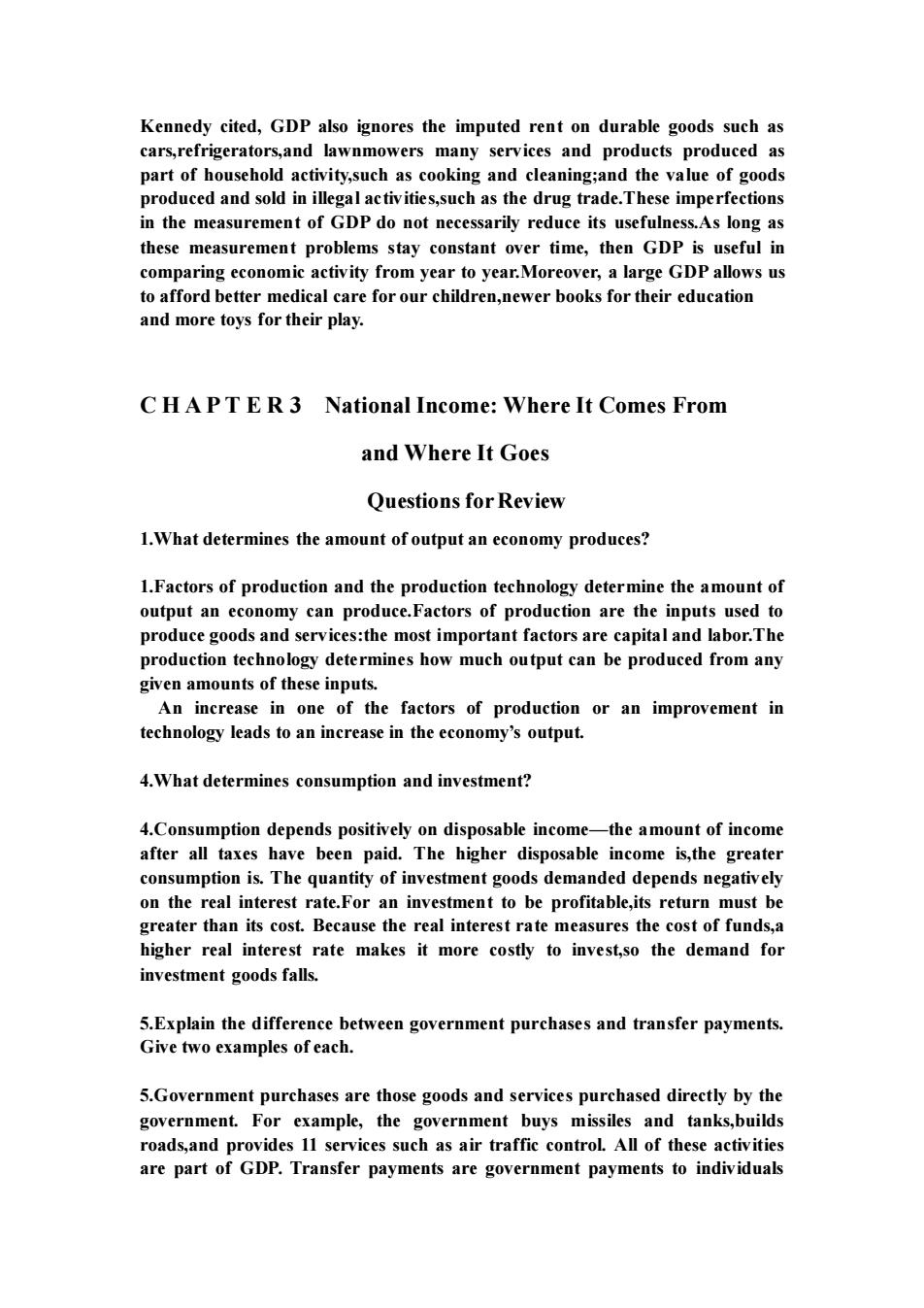
Kennedy cited,GDP also ignores the imputed rent on durable goods such as cars,re gerat wnm owers many se es and pro cts produced as part of house cleaning;and the value of good produced and sold in illegal activities,such as the drug trade.These imperfections in the measurement of GDP do not necessarily reduce its usefulness.As long as these measurement problems stay constant over time,then GDP is useful in 0 rom yea year.Moreo alarge GDP allows us to afford better medical care for our children,newer books for the r education and more toys for their play. CHAPTER3 National Income:Where It Comes From and Where It Goes Ouestions for Review 1.What determines the amount of output an economy produces? 1.Factors of production and the production technology determine the amount of output an economy can produce.Factors of production are the inputs used to produce goods and services:the most important factors are capital and labor.The vei how nch ou pu can be produced from y An increase in one of the factors of production or an improvement in technology leads to an increase in the economy's output. 4.What determines consumption and investment? 4.Consumption depends positively on disposable income -the amount of income after all taxes have been paid.The higher disposable income is,the greater consumption is.The quantity of investment goods demanded depends negatively on the real interest rate for an investment to be profitable its return must be greater than its cos Because the erest rate m easures the cost of funds. higher real interest rate makes it more costly to invest,so the demand for investment goods falls 5.Explain the difference between government purchases and transfer payments. Give two examples of each. 5.Government purchases are those goods and services purchased directly by the government.For example,the government buys missiles and tanks,builds roads,and provides 11 services such as air traffic control.All of these activities are part of GDP.Transfer payments are government payments to individuals
Kennedy cited, GDP also ignores the imputed rent on durable goods such as cars,refrigerators,and lawnmowers many services and products produced as part of household activity,such as cooking and cleaning;and the value of goods produced and sold in illegal activities,such as the drug trade.These imperfections in the measurement of GDP do not necessarily reduce its usefulness.As long as these measurement problems stay constant over time, then GDP is useful in comparing economic activity from year to year.Moreover, a large GDP allows us to afford better medical care for our children,newer books for their education and more toys for their play. C H A P T E R 3 National Income: Where It Comes From and Where It Goes Questions for Review 1.What determines the amount of output an economy produces? 1.Factors of production and the production technology determine the amount of output an economy can produce.Factors of production are the inputs used to produce goods and services:the most important factors are capital and labor.The production technology determines how much output can be produced from any given amounts of these inputs. An increase in one of the factors of production or an improvement in technology leads to an increase in the economy’s output. 4.What determines consumption and investment? 4.Consumption depends positively on disposable income—the amount of income after all taxes have been paid. The higher disposable income is,the greater consumption is. The quantity of investment goods demanded depends negatively on the real interest rate.For an investment to be profitable,its return must be greater than its cost. Because the real interest rate measures the cost of funds,a higher real interest rate makes it more costly to invest,so the demand for investment goods falls. 5.Explain the difference between government purchases and transfer payments. Give two examples of each. 5.Government purchases are those goods and services purchased directly by the government. For example, the government buys missiles and tanks,builds roads,and provides 11 services such as air traffic control. All of these activities are part of GDP. Transfer payments are government payments to individuals